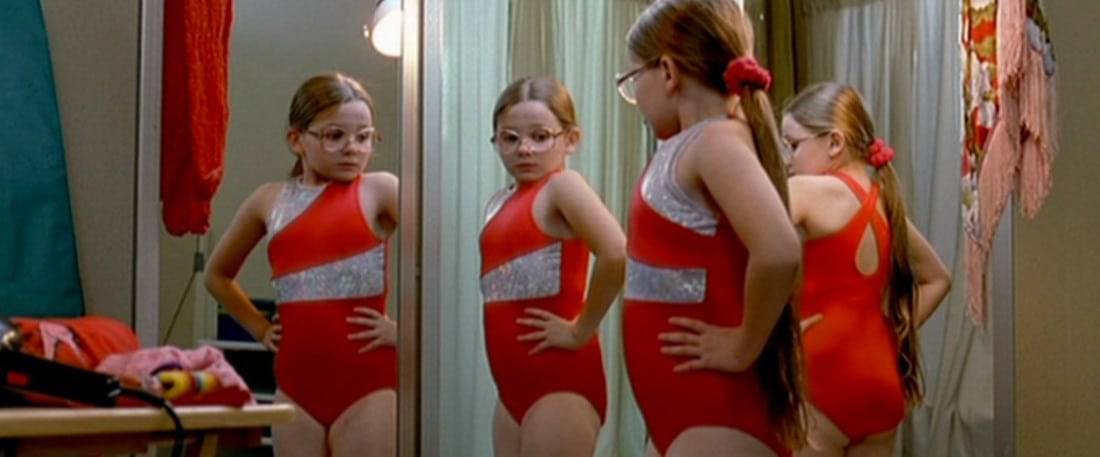Little Miss Sunshine is remembered for many things: its path from Sundance to four Oscar nominations (and one Alan Arkin win!), introducing the world to Abigail Breslin, the iconic yellow Volkswagon microbus, and being a dramedy about a dysfunctional family that feels entirely fresh.
The dysfunctional family in question is the Hoovers. They take a road trip to California so that the youngest of the clan, Olive (Breslin), can perform in the Little Miss Sunshine beauty pageant. Piled into the VW with Olive are: her ever-stressed mother, Sheryl (Toni Collette); her winning-obsessed, “inspirational” father, Richard (Greg Kinnear); her voluntarily mute brother, Dwayne (Paul Dano); her severely depressed uncle, Frank (Steve Carell); and her crude, self-medicating grandpa, Edwin (Arkin). Loads of fun, right?
With no shortage of idiosyncratic character traits, the film’s characters are an obvious standout. But it’s so much more than its compelling characters. The film’s use of setting works wonders to help Little Miss Sunshine apart from others— much of it is spent in the confined space of the VW bus before shifting to the titular pageant. While the close quarters of their road trip bring about many of the film’s best moments, it’s this shift to the pageant for the final act that is the genius of the film.
For a dramedy, the climax happens in an unorthodox way. Instead of in a weepy moment, the Hoovers come together in a dance. While we knew that Olive’s grandpa choreographed for her, it’s a delightful comedic shock when Olive, easily the most innocent and sunshine-y of the family, gets on stage for the talent portion of the pageant and performs a burlesque dance to Rick James’ “Super Freak.” As the audience and judges look horrified, the Hoovers one by one take to the stage and join Olive in a myriad of dances that, much like the family, absolutely shouldn’t go together but somehow do.
It’s an outstanding cinematic moment without trying to be one. It feels organic to these characters as if this is where their paths were always headed all along. More importantly, it feels honest to these characters. It’s easy to believe that they would come together in this way despite their struggle to get on the same wavelength throughout the film — they’re doing it for Olive, after all.
Getting to this moment of honesty is a sign that the sequence was handled well by its directors (married duo Valerie Faris and Jonathan Dayton). An essential part of letting the balance of comedy and emotion ring true was creating a setting real enough for the characters to believably exist in. To get to this point of realism, the directors took all the reigns off. After finding a group of pageant girls and mothers, the two let them do what they would.

“Those were real pageant girls, done up by their mothers. They brought all their own equipment. They brought every aspect of that,” Dayton said in an Epoch Times interview following the film’s release. “We knew [we] couldn’t fake this, because these are girls who have been working at this all their lives.”
After telling the group what a given scene would be, such as the swimsuit competition, one mother would often take charge of the group, making sure that preparations went smoothly for everyone. Then, as if in a real beauty pageant, they would all come out and strike their poses on the stage.
Although the pageant world is one that is often criticized, for Faris and Dayton, the name of the game was avoiding commentary on a community that is often subject to judgment. “If we wanted to make them look bad… there was a scene in there where two little girls laugh at Olive because she’s… chubby,” Faris told the Epoch Times. “They say, ‘Are you on a diet?’ And she says, ‘No.’ And one of them says, ‘I didn’t think so.’ That was a scene; we shot it, we hated it.”
In committing to this more downplayed portrayal of the pageant, Faris and Dayton were able to get at what the scene was all about: the Hoovers being caught in the wrong place but coming together and finding belonging with each other. Dayton captured this idea perfectly in that interview:
“It was very important to us that the film not be about pageants. It’s about being out of place, it’s about not knowing where you’re going to end up.”
The resulting sequence is memorable as comedic gold, of course, but also as a touching moment. For a family marked by dysfunction and disconnection throughout the film, there is something magical and entirely on-brand about a “Super Freak” dance being their connecting moment. It’s a scene that works for all the reasons you wouldn’t expect— it’s an emotional moment told through comedy in a pageant setting not represented as a caricature that ends with all the characters dancing free-spiritedly. For a family that has everything go wrong, that moment of finding each other in a crowd of people unlike them is a beautiful one.
The post How ‘Little Miss Sunshine’ Uses a Pageant to Bring Its Characters Together appeared first on Film School Rejects.
0 comments:
Post a Comment